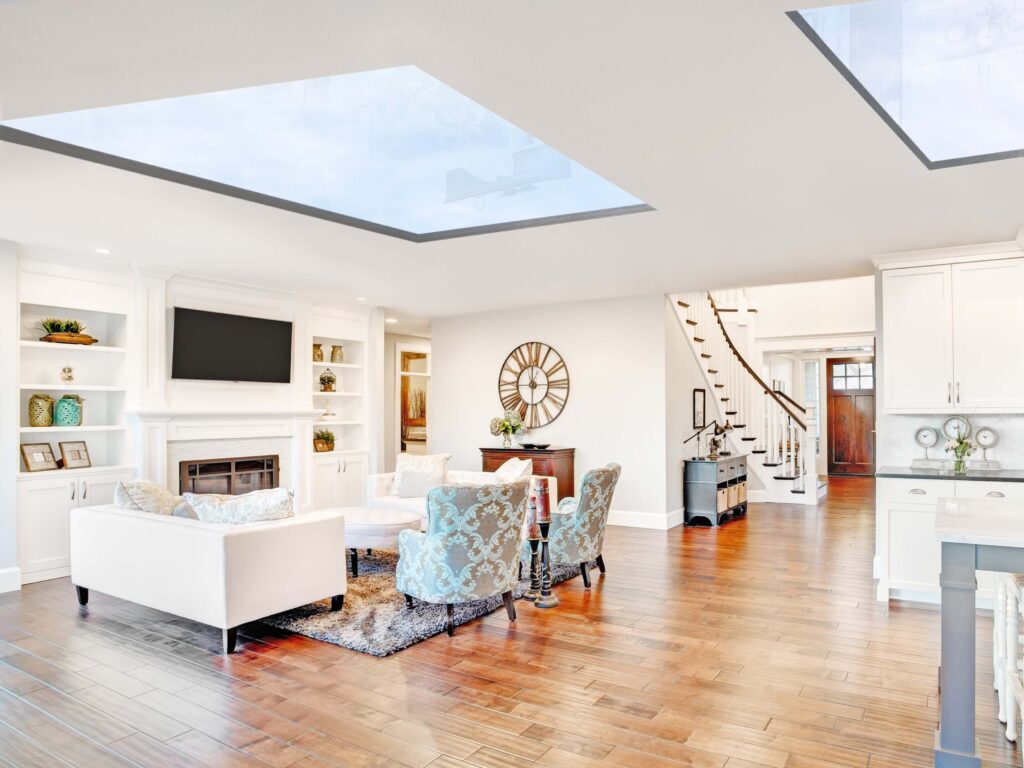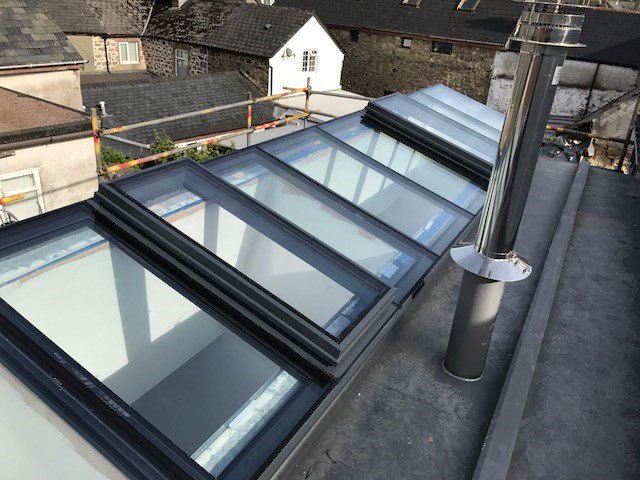Homeowners often struggle to differentiate between the terms rooflight and skylight and can be unsure on the technical definition of each. This can make the process of choosing which one to install difficult because it is unclear which type is the best and the most suitable for their home. While there are variations of both rooflights and skylights, the purpose of each is the same; to allow more natural light into a specific room in the house.
While there are variations of both rooflights and skylights, the purpose of each is the same: to allow more natural light into a specific room in the house.
There are several benefits of bringing natural light into a room, including making a space appear more inviting, boosting the well-being of any occupants, and saving money on energy costs. We have put together the following guide to help you get to grips with the differences between rooflights and skylights, and help you to know which is the best option for your home.

WHAT IS A ROOFLIGHT?
A rooflight is a glazed unit that is typically fitted within a flat roof, or if installed on a pitched roof, it is fitted out of plane with the level of the tiling. Rooflights often use a kerb system when fitted on flat roofs to enable enough height for water to run off. This type of window is available in a large variety of designs to help brighten and suit the style of any room in the house.
Rooflights are a great way to achieve additional natural daylight in a room without having to request planning permission beforehand. This is because rooflights generally maintain the building’s overall aesthetics.
WHAT IS A SKYLIGHT?
They more commonly refer to windows that are installed on traditional-style pitched roofs, but can also indicate bespoke units installed on flat roofs. These glazed units are often extremely different, depending on the type of roof on which they’ll be installed. This is why the term skylight is often considered very broad.
They are available in a range of different styles to meet the requirements of many different homeowners. As well as offering a significant amount of natural daylight, this type of window is often fitted with an electric motor to ventilate the room.
AND WHAT ARE THE BENEFITS?
If you are a regular reader, you will be familiar with other articles in which we talk at length about the benefits of a rooflight installation. It offers a way to improve sustainability and has a number of other advantages. These include:
Improved availability of natural light without privacy compromises
Rooflights and skylights can flood a room with daylight while still preserving privacy, since they are positioned overhead rather than at eye level. This makes them especially useful in bathrooms, bedrooms, and urban homes where outside views might be close by.
Promotion of good health and mood
Exposure to natural light helps regulate the body’s circadian rhythm, which improves sleep quality and daily energy levels. This supports overall health, while the boost in serotonin linked to daylight is directly connected to a better mood. Leaving rooms that feel brighter also makes them feel calmer, happier, and more motivating to spend time in.
Improved ventilation
Opening rooflights and skylights provide a simple way to let in fresh air. This helps to reduce humidity, clear cooking smells, and prevent the build-up of condensation in bathrooms and kitchens. Better airflow also supports indoor air quality by lowering pollutants and excess heat, which creates a healthier, more comfortable environment for daily living.
Maximising energy efficiency with the support of things like low-emissivity glass
By increasing daylight, rooflights and skylights reduce the need for artificial lighting during the day, which lowers electricity use. High-performance glazing, such as low-emissivity glass, also improves insulation by reflecting heat into the room in winter while limiting solar gain in summer. Together, these features help maintain a stable indoor temperature, cut energy bills, and lessen the home’s overall environmental impact.
TYPES OF ROOFLIGHT AND SKYLIGHT
There is a huge variety of these products, which makes them easy to match with any existing interior and exterior aesthetic. Each type of rooflight or skylight has its own strengths, from maximising daylight to improving ventilation or creating access. Understanding these options helps you choose the style that best supports your space and lifestyle. Typically, the most popular styles include:
Sun Tubes: Ideal for awkward spaces, sun tubes are designed to direct natural daylight into even the smallest of rooms. Reflective tubing helps to direct this light, which is then dispersed across the ceiling of a room, and is a stylish solution to bring light into any room. They work particularly well in internal bathrooms, corridors, or stairwells where a traditional window or rooflight would be difficult to install.
Roof Lanterns: Korniche Roof lanterns are a great way to transform any commercial or residential property and can help brighten up a room. This contemporary style of roofing can be customised to suit the needs of any building. They are especially effective in larger open-plan spaces, where the raised profile adds both architectural interest and a flood of daylight from multiple angles.
Walk on Rooflights: This style of rooflight is popular for use on terraces where pedestrians are frequent. Walk on rooflights are designed with this in mind and are strengthened while still allowing a great amount of natural daylight into a room. They create a seamless link between indoor and outdoor spaces, making roof terraces more usable while maintaining light in the rooms below.
Opening Rooflights: Opening rooflights both brighten and ventilate any room and help you to remain in control of the temperature by opening only to a specific point. This style is perfect for when roof access is not required and the window only needs a small opening. They are ideal for kitchens, bathrooms, or loft rooms, where the balance of light and airflow makes the space more comfortable to use every day.
Electric Rooflights: Electric rooflights are the perfect solution to help brighten up a room, as well as allowing ventilation. The electric hinges allow these windows to be controlled from a panel or remote, which is ideal for installation on high, out-of-reach ceilings. They can also be fitted with rain sensors or smart controls, offering extra convenience and peace of mind in busy households.
Sliding Rooflights: Sliding rooflights have a mechanism that supports the rooflights’ own weight and eliminates the need for tracks. The ability to open the rooflight means that not only is the room full of natural light, but fresh air too. This design creates a wider opening than hinged options, making it well-suited for roof terraces or spaces that benefit from a greater indoor-outdoor flow.

MATERIALS
Another important step is choosing between glass or polycarbonate roof windows. Glass is the more traditional option and has a number of benefits, including aesthetic, laminated glass is very safe, and the ability to choose the type of glazing, which determines the level of insulation. On the other hand, others opt for polycarbonate windows due to lower prices, the strength of the material, and relative light weight.
Beyond this first choice, there are several glazing options that can enhance performance. Solar-control glass helps to reduce glare and overheating, which is particularly valuable in south-facing rooms. Triple glazing provides superior insulation, keeping the space warmer in winter and cooler in summer, while also helping to cut noise in busy locations.
Frames are also an important consideration. Aluminium frames with thermal breaks offer strength, contemporary style, and excellent insulation. uPVC frames provide a low-maintenance, cost-effective solution. Bespoke aluminium finishes, including powder-coated colours, allow you to match the rooflight or skylight with both interior and exterior aesthetics.
CHOOSING THE RIGHT OPTION
Selecting between a rooflight and a skylight starts with your roof. On a flat roof, a rooflight on an upstand creates a clean look and helps with drainage around the unit. On a pitched roof, a skylight sits in plane with the tiles or slates, using flashing kits that shed water neatly and keep the finish tidy.
How the Room Will Be Used
Each space in the home has different requirements:
- Kitchens benefit from strong daylight over worktops and an opening unit to keep the air fresh. Fixed rooflights suit islands or dining areas, while vented models clear steam and odours.
- Bathrooms need both ventilation and privacy. Obscured or patterned glass works well, and an opening rooflight helps reduce condensation.
- Bedrooms and loft rooms often call for softer light, blackout options and quiet operation. Blackout blinds and solar-control glass can make the space more comfortable for sleep.
- Stairwells and hallways are brightened by one well-placed unit. A slightly larger aperture can pull light through the house, while safety glass is important over circulation areas.
- Home offices benefit from consistent, low-glare daylight. Diffused glass or blinds can reduce screen glare, and a modest opening unit provides airflow on long workdays.
Fixed or Opening
Fixed units maximise daylight and keep the lines simple, while opening units add ventilation and comfort. Manual controls suit units within reach, while electric models are ideal for high ceilings and can include extras like rain sensors.
Access Requirements
If you need safe roof access for maintenance, a roof access unit with secure hinges and stays is the right choice. For roof terraces, a walk-on glass option provides light to the room below while acting as part of the outdoor surface.
Privacy and Glare
Integrated blinds, tinted or solar-control glass, and obscured glazing all help manage comfort without sacrificing natural light. These solutions are especially useful in bedrooms and bathrooms.
Energy and Comfort
Look for low-emissivity glass and insulated frames with thermal breaks. These features keep warmth inside during winter and reduce overheating in summer, making the extension more comfortable and energy efficient.
Budget and Maintenance
Glass gives clear views and long-lasting durability. Polycarbonate is lighter and often more cost-effective. Aluminium, uPVC, and timber-clad frames each bring their own look and level of upkeep. Talking through your roof build-up, insulation, and waterproofing with your supplier will confirm the best fit for your project.
BRING MORE LIGHT INTO YOUR HOME
Rooflights and skylights each offer their own strengths, but both share the ability to flood your home with natural daylight, improve ventilation, and enhance everyday comfort. Choosing the right style and material ensures you get the best balance of light, privacy, and efficiency for your space.To discuss the most suitable options for your project, get in touch with the team at Rooflight Centre. Our experts are ready to guide you through every stage, or you can browse our guides and brochures for more ideas.

